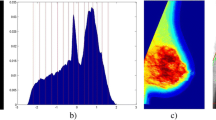Abstract
The purpose of this paper is to compare subregional breast density and whole breast density and their association with breast cancer risk. The film mammograms of 278 cases and 834 age and ethnicity-matched controls were digitized and analyzed using single-energy x-ray absorptiometry (SXA). The subregion was a 3-cm diameter circle centered in the breast. The whole and subregional densities are found to be highly correlated (r2=0.7). The 4:1 quartile odds ratio after controlling for other significant risk factors (age, BMI, family history and age at first live birth) was 3.6 (95 CI 2.1-5.4) and the 2.4 (95 CI 1.5-3.7) for the whole and subregional breast density, respectively. Further studies are underway to optimize the placement of the ROI and combined multiple regions.
Access this chapter
Tax calculation will be finalised at checkout
Purchases are for personal use only
Preview
Unable to display preview. Download preview PDF.
Similar content being viewed by others
References
Pinto Pereira, S.M., et al.: The spatial distribution of radiodense breast tissue: a longitudinal study. Breast Cancer Res. 11(3), R33 (2009)
Taroni, P., et al.: Seven-wavelength time-resolved optical mammography extending beyond 1000 nm for breast collagen quantification. Opt. Express. 17(18), 15932–15946 (2009)
Stromberg, C.N., et al.: Radiographic risk signs for loosening after cemented THA: 61 loose stems and 23 loose sockets compared with 42 controls. Acta Orthop. Scand. 67(1), 43–48 (1996)
Glide-Hurst, C.K., Duric, N., Littrup, P.: Volumetric breast density evaluation from ultrasound tomography images. Med. Phys. 35(9), 3988–3997 (2008)
Ursin, G., et al.: Greatly increased occurrence of breast cancers in areas of mammographically dense tissue. Breast Cancer Res. 7(5), R605–R608 (2005)
Vachon, C.M., et al.: Mammographic breast density as a general marker of breast cancer risk. Cancer Epidemiol Biomarkers Prev. 16(1), 43–49 (2007)
Shepherd, J.A., et al.: Novel use of single X-ray absorptiometry for measuring breast density. Technol. Cancer Res. Treat. 4(2), 173–182 (2005)
Shepherd, J.A., et al.: Clinical comparison of a novel breast DXA technique to mammographic density. Med. Phys. 33(5), 1490–1498 (2006)
Mandelblatt, J.S., et al.: Effects of mammography screening under different screening schedules: model estimates of potential benefits and harms. Ann. Intern. Med. 151(10), 738–747 (2009)
Author information
Authors and Affiliations
Editor information
Editors and Affiliations
Rights and permissions
Copyright information
© 2010 Springer-Verlag Berlin Heidelberg
About this paper
Cite this paper
Malkov, S., Ma, L., Kerlikowske, K., Wang, J., Cummings, S., Shepherd, J. (2010). Comparison of Subregional Breast Density with Whole Breast Density. In: Martí, J., Oliver, A., Freixenet, J., Martí, R. (eds) Digital Mammography. IWDM 2010. Lecture Notes in Computer Science, vol 6136. Springer, Berlin, Heidelberg. https://doi.org/10.1007/978-3-642-13666-5_54
Download citation
DOI: https://doi.org/10.1007/978-3-642-13666-5_54
Publisher Name: Springer, Berlin, Heidelberg
Print ISBN: 978-3-642-13665-8
Online ISBN: 978-3-642-13666-5
eBook Packages: Computer ScienceComputer Science (R0)




